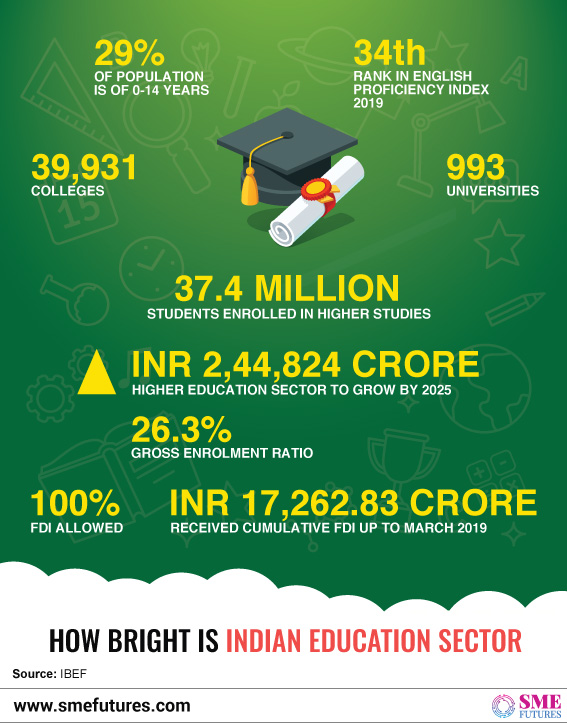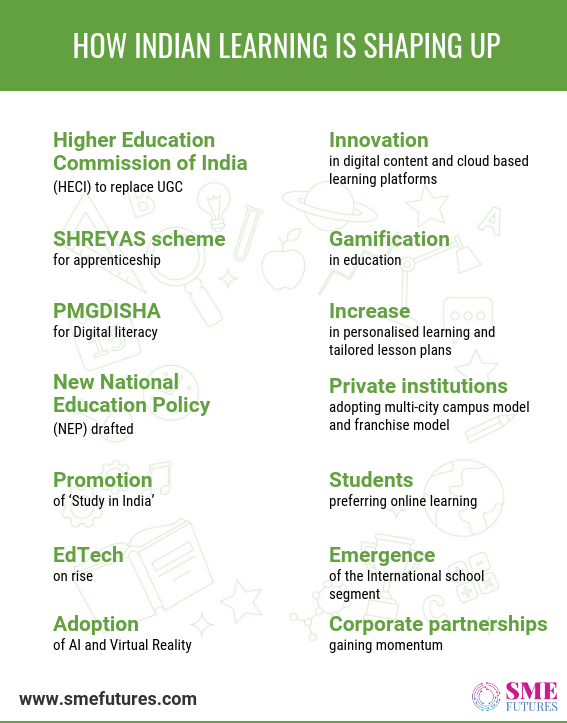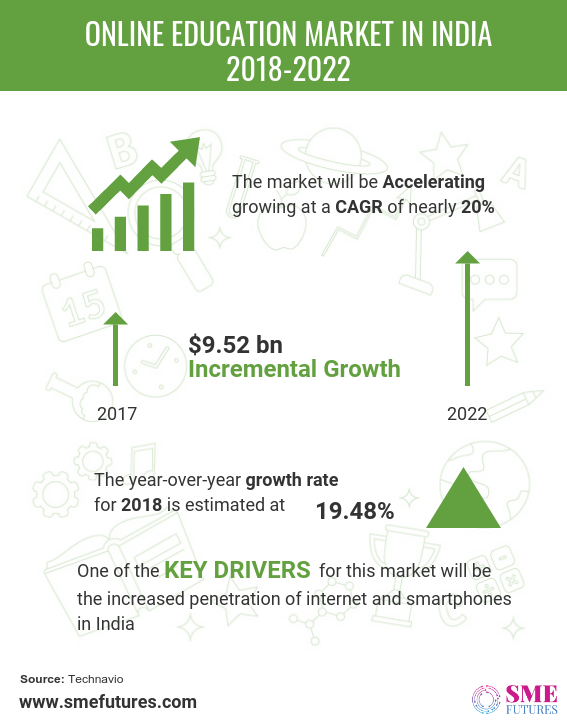In 2019, India’s education sector was quite eventful as slew of initiatives were announced by the Ministry of Human Resource Development. Some of the important ones include, The Draft Higher Education Commission of India Bill that seeks to replace the existing UGC with the Higher Education Commission of India (HECI), Higher Education Youth in Apprenticeship and Skills (SHREYAS) among others.
The HECI Bill aims to promote the autonomy of higher education institutions, reduce the scope of regulation, and eliminate interference in the management of higher educational institutions. Whereas, the SHREYAS scheme was launched to provide apprenticeship opportunities and enhance employability through the National Apprenticeship Promotional Scheme (NAPS). In another initiative, under the Pradhan Mantri Gramin Digital Saksharta Abhiyan (PMGDISHA), over Rs 2 crore of rural Indians have been made digitally literate.
With approximately 29 per cent of India’s population being between the age group of 0-14 years, the education sector remained a priority of the government last year. But it remains to be seen what the Year 2020 holds for this sector.

New National Education Policy shaped up in 2019
The draft National Education Policy (NEP) 2019 details a road map for the future of education in the country. It outlines implementation models at the government-level and focuses on mitigating manpower challenges in the sector. No matter how many rounds of consultations were required to shape up the policy, concerns over funding to implement NEP were raised by some state governments and stakeholders.
“A policy can be judged to be good only when its main purpose and its goals – reorganize higher education institutions into large, multidisciplinary universities, phase out the system of affiliated colleges, tenure-track of teachers, autonomy and deregulation – are realized.”
Sudarshan Ramaswamy, Dean, Jindal School of Government and Public Policy
The policy comprises not only why and what is to be done, but also how. A great deal depends on procedures and processes, which are always fraught with the risk of bureaucratic derailment, Mr. Ramaswamy adds.
Study in India promoted. But, foreign degrees among Indian students still in demand
Apart from new education policy, year 2019 witnessed the launch of ‘Study in India’ – the scheme that aims at attracting International students from select 30 plus countries across South-East Asia, Middle East and Africa. The programme envisages participation of select reputed Indian institutes / universities by way of offering seats for the foreign students at affordable rates, along with 100 per cent fee waivers to meritorious students.
Amol Arora, vice chairman and MD, Shemford Group of Futuristic Schools believes that the Study in India scheme holds the potential to put ‘India on the world map.’ However, we still need a series of fundamental structural reforms that need to be implemented, he adds.
The Government of India may have been working on attracting foreign students, but foreign degrees are still very much in demand among Indian students and this trend is only going to increase in future.
“So far this year has been quite an eventful with almost half a million students from India went abroad for higher education. Indian talent is so much in demand on the global front that all these countries lined up to attract Indian students with favourable policies. All major host countries like Australia, Canada, UK, the USA and others now have gone up and we have not seen any slowdown.”
Rohit Sethi, Director, ESS Global-Study Abroad Consultant.
“We hope the trend continues in the year 2020. New Zealand, Germany and France are few countries that will rule 2020 in the study abroad sector,” Sethi claims.
Technology revolutionizing education space
Technology is one of the biggest factors shaping up the education domain in India. The increase in smartphone penetration and cheaper Internet, there is a plethora of innovation in this space in the form of digital content and classrooms, online assessments and cloud-based platforms.
Some of the practices that are revolutionizing the Indian education system currently, and will continue to do so are as follows:
Experiential learning techniques: Virtual labs, social media platforms, virtual and augmented reality tools, and gamification of learning are enabling students to be actively involved in defining problems, asking questions, experimenting, analyzing results and constructing meaning. It provides an immersive, real-life experience, and is effective in maximizing student motivation and engagement, while developing and instilling in them 21st-century skills, such as communication, collaboration, and creativity.
“The integration of technology in education, which is giving impetus to initiatives such as online teacher training and integrated learning, is expected to continue at a fast pace throughout the country. These initiatives have facilitated the popularity of new-age pedagogies, empowering students with self-learning abilities through e-learning tools as well as the adoption of experiential learning solutions for a holistic learning experience.”
Beas Dev Ralhan, co-founder and CEO, Next Education India.
Artificial intelligence and cloud computing: AI has made considerable inroads in education across the world, and India is no exception. Some of the key challenges faced in the education sector in India is the all-round management of schools, streamlining of assessments and implementation of personalized learning. AI, along with cloud technology, is helping overcome these challenges with online data management and adaptive learning techniques – providing means to personalize education in the country.
Commenting on the popularity of personalized education, Akhand Swaroop Pandit, CEO and founder, Catalyst Group, an online learning platform informs, “EdTech and AI technology have evolved more to cater to personalized learning styles and diverse individual needs. In 2020, we will see increased integration across the globe of personalized learning. Just in time assessment will assist teachers to intervene at appropriate stages and tailor lesson plans accordingly.”
Cost management is going to be the latest trend this year where cloud computing and Blockchain technology will play a significant part,
Akand Swaroop Pandit, CEO and founder, Catalyst Group
“With the increased adoption of ed-tech, the administration will have to strategize and plan their investments accordingly. In the next few years from 2020, education organizations will aim to leverage the benefits of cloud-based technologies to drive cost savings and operational efficiencies. In addition to this, the sector will look towards utilizing blockchain technology to cut paper and printing costs by digitally storing student certificates and diplomas, cost and labour savings by transferring the control of storing personal data to the applicants, litigation cost savings due to loss of documents and damage,” he believes.

Online learning picking up pace
India has become the second largest market for e-learning after the US. According to KPMG and Google study, online education in India is likely to be US$ 2 billion industry by 2021.
Students are now preferring online learning at the comfort of their home with e-learning platforms such as Coursera, Udemy, Udacity, Edx and Catalyst making education accessible to everyone at anywhere, anytime. New concepts are also picking up pace.
For an instance, Byju’s app is used by more than 400,000 students, ranging from K-12 students to students preparing for competitive exams. In January 2019, the company acquired US-based learning platform Osmo for US$ 120 million to drive its international expansion plans.
The market size of digital publishing for the education sector in India has increased at a CAGR of 5.29 per cent year-on-year to US$ 356 million in 2017 from US$ 305 million in 2014. As of March 2019, the government is also taking the initiative to encourage colleges to offer online courses in rural areas to ensure education for all.

Other notable trends in this space:
- Private institutions adopting multi-city campus model to scale up their operations and expand in the untapped market of tier 2 and tier 3 cities.
- Private schools adopting the franchise model to ensure economic viability
- Emergence of the International school segment as more Indian players are collaborating with international brands to provide international standard quality education.
- Corporate partnerships are also gaining momentum. Companies are training college pass-outs with both soft and hard skills required by their corporate partners. In April 2018, National Programme on Technology Enhanced Learning (NPTEL) and Internshala signed an MoU to provide internships in over 1,800 colleges in India.
Conclusion
Today, India has over 250 million school going students, more than any other country. Being one of the largest networks of higher education institutions in the world, 37.4 million students enrolled in higher education in 2018-19, while gross enrollment ratio (the percentage of students in higher education of the total eligible population in the 18-23 age group) reached 26.3 per cent during the same period, according to the data revealed by the HRD ministry.
The education sector in India will remain to be a strategic priority for the government. The government has already provided ₹400 crore for ‘World Class Institutions’. While it has proposed a 12.8 per cent year-on-year increase in FY20 allocation of ₹56,536.36 crore for school education.
Having said that, there is a huge demand and supply gap that persists in the sector, offering opportunities for various players to tap. Besides that, girls dropout rate in comparison to boys in the primary and secondary levels also concerns the industry. Only quality education focussed on research and that leads to sustainable job opportunities can positively impact the economy and society at large in the long run.











